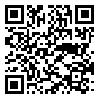Volume 28, Issue 10 (12-2020)
JSSU 2020, 28(10): 3144-3152 |
Back to browse issues page
Download citation:
BibTeX | RIS | EndNote | Medlars | ProCite | Reference Manager | RefWorks
Send citation to:



BibTeX | RIS | EndNote | Medlars | ProCite | Reference Manager | RefWorks
Send citation to:
Nabi Meybodi M, Arbab Tafti N, Ramezani V, Tavakolian Ardakani M, Akrami M, Ranjbar Jamal abadi A M. Evaluation of Herbal Medicine Administration by Physicians in the Prescriptions of Yazd State Pharmacy. JSSU 2020; 28 (10) :3144-3152
URL: http://jssu.ssu.ac.ir/article-1-5186-en.html
URL: http://jssu.ssu.ac.ir/article-1-5186-en.html
Mohsen Nabi Meybodi 

 , Neda Arbab Tafti
, Neda Arbab Tafti 

 , Vahid Ramezani *
, Vahid Ramezani * 

 , Mahsa Tavakolian Ardakani
, Mahsa Tavakolian Ardakani 

 , Maryam Akrami
, Maryam Akrami 

 , Ali mohammad Ranjbar Jamal abadi
, Ali mohammad Ranjbar Jamal abadi 




 , Neda Arbab Tafti
, Neda Arbab Tafti 

 , Vahid Ramezani *
, Vahid Ramezani * 

 , Mahsa Tavakolian Ardakani
, Mahsa Tavakolian Ardakani 

 , Maryam Akrami
, Maryam Akrami 

 , Ali mohammad Ranjbar Jamal abadi
, Ali mohammad Ranjbar Jamal abadi 


Abstract: (1552 Views)
Introduction: Herbal medicines are one of the most widely used complementary therapies in the world. Therefore, it is necessary to perform exact studies on the status of herbal medicines in communities. The aim of this study was surveying the prescription amount of herbal medicines prescribed by physicians and the effect of variables such as gender, degree of education, age, type of specialization of physicians, different seasons, source of drug production, price and the rate of insurance coverage on it.
Methods: The current study was a descriptive-analytical and cross-sectional one. This research was conducted in the period of April 1 to March 20, 2016 in a public pharmacy in Yazd. 1824 prescriptions were obtained using Cochran's statistical formula and the amount of prescription containing herbal medicines was evaluated using the prepared lists. The collected data in three general categories, including physicians' demographic characteristics, prescriptions and their containing drugs specification were analyzed using SPSS (version 16) software and using the Chi-square statistical test.
Results: Among the 1824 prescription examined, only 120 prescriptions contained herbal medicines with the average number of 1.05 ± 0.22 herbal medicine items in each prescription. 114 prescriptions (95%) and 6 prescriptions (5%) included one and two herbal items, respectively. There was a significant relationship between the amount of herbal medicine and the degree (P=0.041), type of specialization (P=0.04) and gender of the doctors (P=0.009), however, there was no significant relationship between the amount of prescription containing herbal medicines, the seasons of prescription (P=0.866) and the age of the physicians (P=0.089).
Conclusion: Considering the results of this study, the amount of herbal medicines prescribed by physician in Yazd city is low.
Methods: The current study was a descriptive-analytical and cross-sectional one. This research was conducted in the period of April 1 to March 20, 2016 in a public pharmacy in Yazd. 1824 prescriptions were obtained using Cochran's statistical formula and the amount of prescription containing herbal medicines was evaluated using the prepared lists. The collected data in three general categories, including physicians' demographic characteristics, prescriptions and their containing drugs specification were analyzed using SPSS (version 16) software and using the Chi-square statistical test.
Results: Among the 1824 prescription examined, only 120 prescriptions contained herbal medicines with the average number of 1.05 ± 0.22 herbal medicine items in each prescription. 114 prescriptions (95%) and 6 prescriptions (5%) included one and two herbal items, respectively. There was a significant relationship between the amount of herbal medicine and the degree (P=0.041), type of specialization (P=0.04) and gender of the doctors (P=0.009), however, there was no significant relationship between the amount of prescription containing herbal medicines, the seasons of prescription (P=0.866) and the age of the physicians (P=0.089).
Conclusion: Considering the results of this study, the amount of herbal medicines prescribed by physician in Yazd city is low.
Type of Study: Original article |
Received: 2020/07/15 | Accepted: 2020/12/30 | Published: 2020/12/30
Received: 2020/07/15 | Accepted: 2020/12/30 | Published: 2020/12/30
Send email to the article author
| Rights and permissions | |
 |
This work is licensed under a Creative Commons Attribution-NonCommercial 4.0 International License. |




